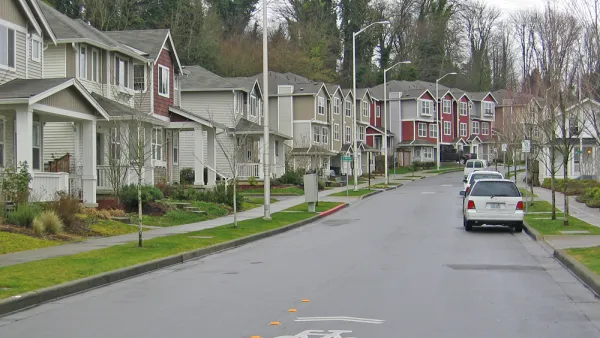The city of Minneapolis approved an interim inclusionary zoning measure in December 2018, but very few projects were subject to the policy. Supporters and opponents of the policy are sparring over the policy's future.

Jessica Lee reports:
In Minneapolis, the City Council adopted an interim ordinance for inclusionary zoning last December, a vote that coincided with Minneapolis 2040, the city’s long-term plan for development. The ordinance calls for developers of new rental properties to make 10 percent of their units affordable to households that earn 60 percent of the area’s median income (AMI), or $56,580 annually for a family of four. Developers who get tax increment financing from the city, meanwhile, have to make 20 percent of their units affordable to households that earn 50 percent AMI (or slightly more than $47,000 per year for a family of four), which translates to a monthly maximum rent of roughly $1,179.
Opponents of inclusionary zoning are calling for the city to transition to a tax increment financing (TIF) system to raise money for affordable housing. Numerous advocates—from the Sightline Institute, George Mason University, local nonprofit developers, and local for-profit developers—are cited in both critiquing inclusionary zoning as an effective policy tool and in suggesting ways that inclusionary zoning can be implemented without stifling development entirely.
Minneapolis hired Portland-based housing nonprofit Grounded Solutions Network to research the city's interim policy and recommend revisions for making the policy permanent.
Grounded Solutions is recommending dialing back requirements from the city’s current policy. Under the recommendations, developers of new rental properties would need to make 8 percent (instead of 10 percent) of their units affordable to households that earn 60 percent AMI, or 4 percent for households that earn 30 percent AMI ($28,300 annually). Developers who get tax increment financing from the city would still have to make 20 percent of their units affordable to households that earn 50 percent AMI or go through other steps to prove that that requirement would hinder the construction project.
The article also provides thorough treatment of the development and housing affordability context of Minneapolis, as well as the national trend toward adopting inclusionary zoning as an affordable housing development tool.

National Parks Layoffs Will Cause Communities to Lose Billions
Thousands of essential park workers were laid off this week, just before the busy spring break season.

Retro-silient?: America’s First “Eco-burb,” The Woodlands Turns 50
A master-planned community north of Houston offers lessons on green infrastructure and resilient design, but falls short of its founder’s lofty affordability and walkability goals.

Delivering for America Plan Will Downgrade Mail Service in at Least 49.5 Percent of Zip Codes
Republican and Democrat lawmakers criticize the plan for its disproportionate negative impact on rural communities.

Test News Post 1
This is a summary

Test News Headline 46
Test for the image on the front page.

Balancing Bombs and Butterflies: How the National Guard Protects a Rare Species
The National Guard at Fort Indiantown Gap uses GIS technology and land management strategies to balance military training with conservation efforts, ensuring the survival of the rare eastern regal fritillary butterfly.
Urban Design for Planners 1: Software Tools
This six-course series explores essential urban design concepts using open source software and equips planners with the tools they need to participate fully in the urban design process.
Planning for Universal Design
Learn the tools for implementing Universal Design in planning regulations.
EMC Planning Group, Inc.
Planetizen
Planetizen
Mpact (formerly Rail~Volution)
Great Falls Development Authority, Inc.
HUDs Office of Policy Development and Research
NYU Wagner Graduate School of Public Service





























